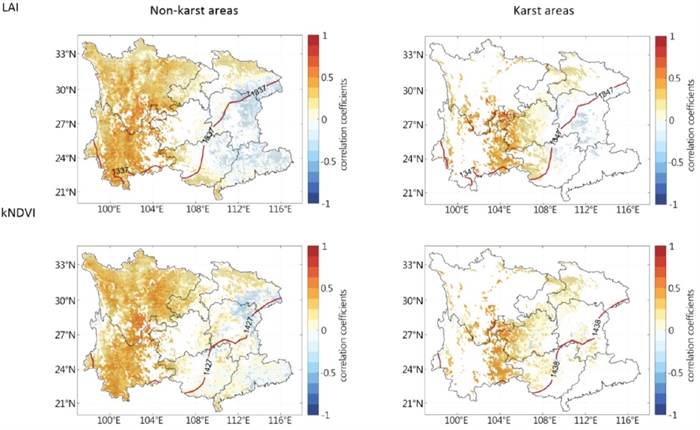Precipitation Sensitivity Thresholds Clarified for Vegetation Growth in Karst
Large-scale ecological projects have significantly “greened” the karst region in Southwest China over the past 20 years. However, the fragile geological setting, the frequent occurrence of extreme droughts in recent years, in the context of global climate change, has increased uncertainty and risk in the recovery and growth of vegetation.
“We try to distinguish the sensitivity of vegetation to meteorological drought under different geological conditions and to determine the precipitation thresholds for vegetation sensitivity.” said Prof WANG Kelin from the Institute of Subtropical Agriculture of Chinese Academy of Sciences, “which are both crucial for the sustainable greening of Southwest China.”
Researchers selected the Leaf Area Index (LAI) and the kernel Normalized Difference Vegetation Index (“kNDVI”) as the indicators of vegetation growth, explored regional variations in the response of vegetation to precipitation in both karst and non-karst areas across eight provinces in Southwest China, and clarified precipitation sensitivity thresholds for vegetation growth across different geological backgrounds.
Their results showed that vegetation in karst regions is more sensitive to changes in precipitation and its seasonality, while vegetation growth in non-karst areas is more influenced by temperature. By controlling for temperature effects, the team established an annual average precipitation threshold of 1,337 mm to 1,438 mm to identify areas where vegetation is highly sensitive to precipitation.
Additionally, in karst regions, the threshold for vegetation resilience is slightly higher, indicating that these areas are more vulnerable to prolonged droughts. Data from the past 20 years reveal that the proportion of karst areas experiencing precipitation below this threshold is significantly higher than in non-karst areas, particularly during extreme drought years such as 2011, when nearly all karst regions fell below this threshold. This demonstrates the extreme sensitivity of karst ecosystems to changes in precipitation, highlighting the increased drought risks these areas face due to global climate change.
“Our study emphasizes the importance of considering geological backgrounds when developing climate adaptation strategies and forest management practices.” said YUE Yuemin, corresponding author of the study. “In karst regions, where initial greening efforts have shown success, adaptive management measures that enhance the sustainability and stability of ecological restoration are critical. These efforts will help mitigate the impacts of changing precipitation patterns and consolidate the achievements of greening in these fragile ecosystems.”
The research has been published in Journal of Hydrology on September 4th.
Contact: Yue Yuemin
E-mail: ymyue@isa.ac.cn

The correlation analysis between vegetation indexes (LAI and kNDVI) and monthly precipitation in karst and non-karst areas(Image by Wang Lu)
Download attachments: